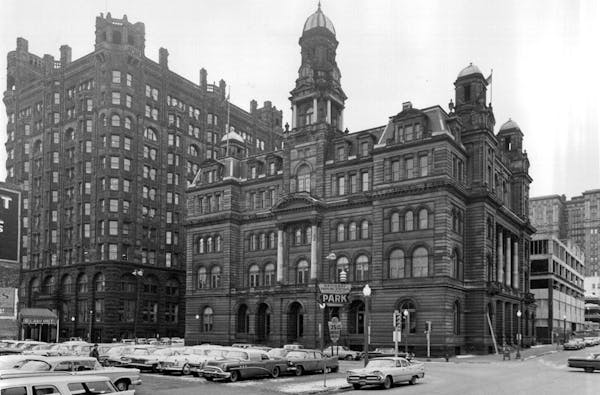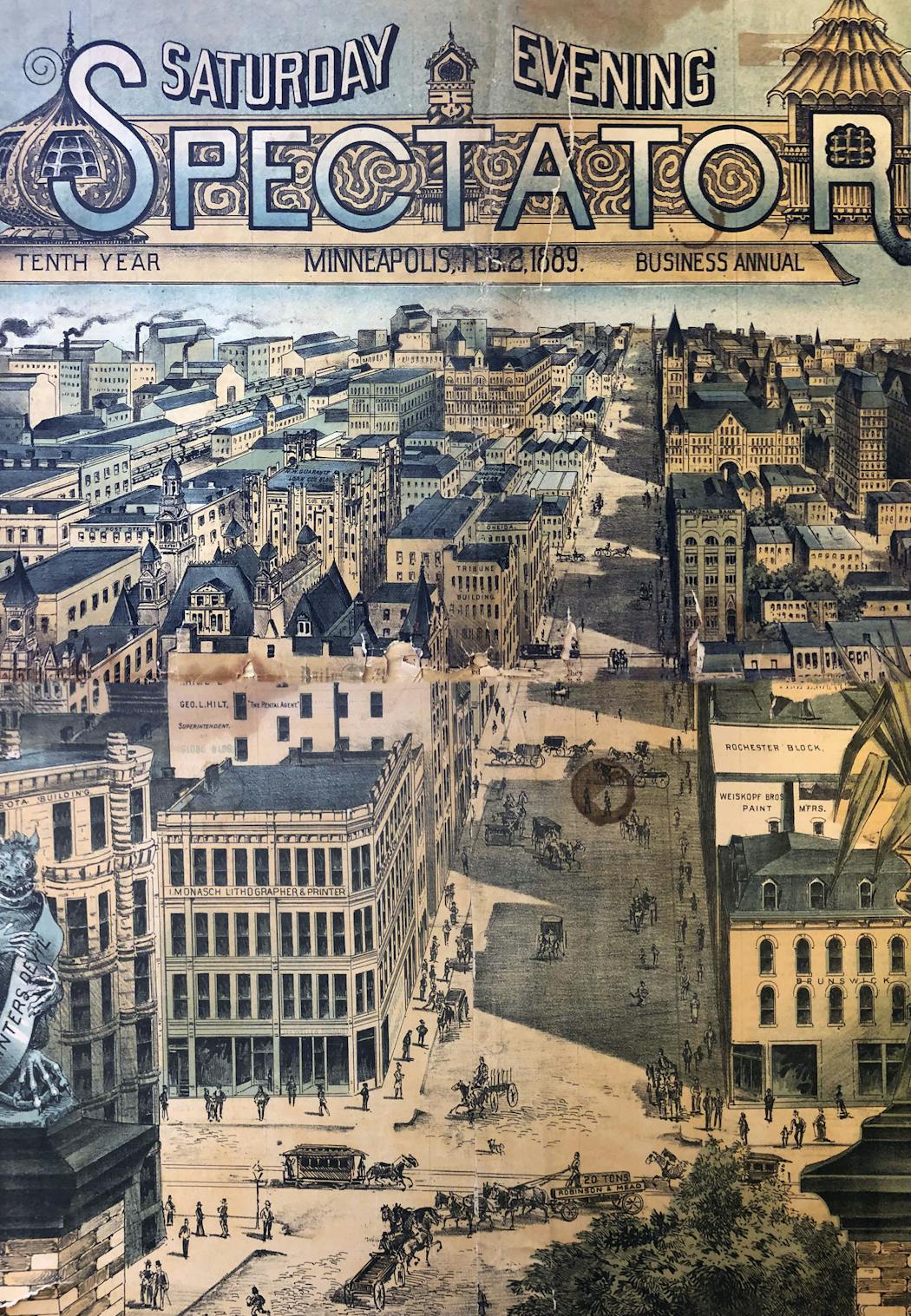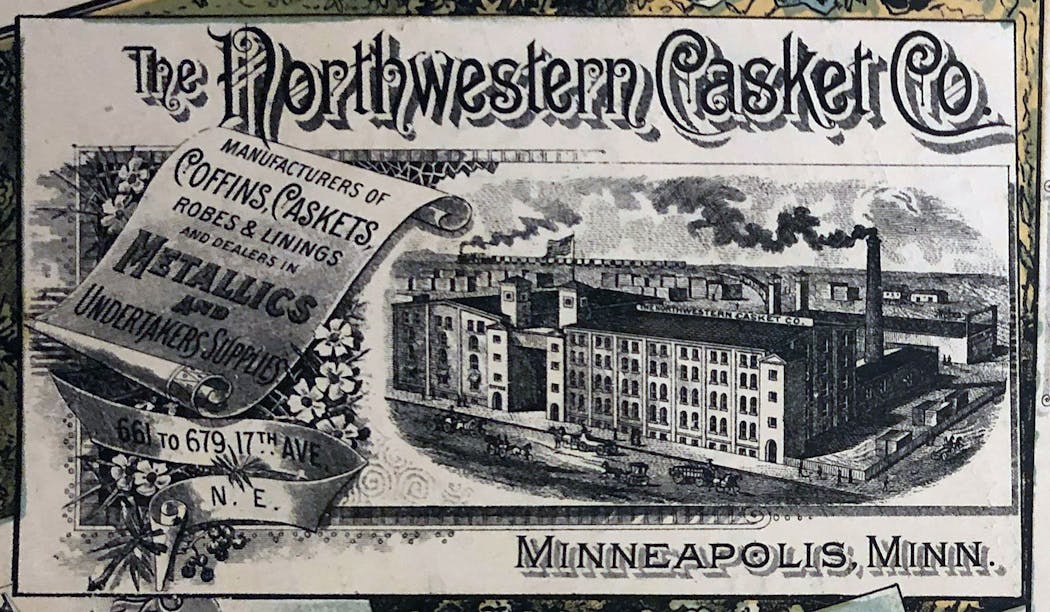Found in a stack of ancient paper at an antiques show, wrapped in plastic, smelling of old books and crammed attics: the Saturday Evening Spectator from 1889.
The cover of the Minneapolis newspaper featured an illustration of the city, with the intersection of Hennepin Avenue and 4th Street front and center. What's so interesting about the illustration? Nearly every building it depicted is gone. Except for the one that wasn't built yet.
The year 1889 was a typical year in the history of a booming river town. The electrification of the streetcar system had begun. Minnehaha Falls had been purchased for use as a park. City Hall, however, was yet to be completed. But because it was in the works, the illustration on the cover of the Spectator assumed its existence.
Many of the rest of the buildings depicted are a gallery of ghosts — the Kasota building, the Oneida, the Metropolitan building (originally known as the Northwestern Guaranty Loan Building). All of them were lost to time and urban renewal.
Interestingly, some of the other buildings included in the illustration are fancies. The tall double tower with the mansard roof shown to the right of City Hall? That never got built. The Chamber of Commerce building to the left of City Hall? It's really the Grain Exchange, and it never looked like that.
The cover of the Spectator was certainly colored by boosterism. The rest of the weekly newspaper was filled with endless encomiums to progress, listing this many board-feet of lumber hewed, that many building permits granted, and such-and-such money on deposit in the banks. Sure, the stories were self-congratulatory, but, heck, the city had earned it: Minneapolis had been platted out only 45 years earlier.
One page of the newspaper stands out. It's filled with paid advertisements that look like a collection of elaborately illustrated business cards, each touting a firm. Each tells a story of a real building.
The Northwestern Casket Building was — and is — a neighborhood landmark. The company made more than caskets. It also made burial clothes, ambulances and other burial essentials. In 1889, business was good. Lumber arrived daily; finished coffins went out the other side of the northeast Minneapolis factory, and were shipped wherever needed.
The 1882 building is still standing, which makes it one of the city's most venerable citizens. It has a new life as the Casket Arts Building. The business is still around, too. It's now located in the last place you might expect funereal products: New Hope.
George Van Dusen made his money building grain elevators along the expanding rail lines. This card shows the Star Elevator, which (according to a late-19th-century account of a building collapse) was located on 1st Street between 5th and 6th Avenues N. in downtown. There's not a trace of that building today, but the Van Dusen mansion still stands at 1900 LaSalle Av. S. in Minneapolis. It's used as an events center. Probably not how Van Dusen thought his name would live on.
A.H. Ives was selling caramel at the end of the 19th century from his three-story building at 216 N. 2nd St. He shifted from candy to ice cream, becoming one of Minneapolis' top vendors. "Eat a Plate of Ice Cream Every Day" was the slogan. The Ives building still stands, and it's been freshly renovated. (Ives eventually moved his facility to the 200 block of University Avenue SE. in 1923. That building still stands, as well.)
Built in 1886, the Temple Court building on 2nd Street and Hennepin Avenue was a prime address. Along with the nearby Boston Block, it anchored the office district of Hennepin Avenue. Today, these buildings would likely be refurbished as boutique hotels. Unfortunately, they were demolished.
The Minneapolis Iron Store Co. was prosperous enough to outgrow its building at 240 1st Av. S. and move into a much larger facility at the intersection of 2nd Street and 2nd Avenue S. which still exists. The business does not.

Travis Kelce named host of 'Are You Smarter than a Celebrity?' for Prime Video
West Virginia transgender sports ban discriminates against teen athlete, appeals court says







